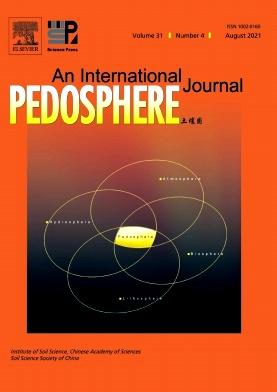微生物Fe(III)还原后的Fe(II)氧化不引起Cd释放
IF 5.2
2区 农林科学
Q1 SOIL SCIENCE
引用次数: 0
摘要
土壤淹水和排水可以引起铁(Fe)的还原和氧化,以及镉(Cd)的固定和动员。然而,微生物Fe(III)还原后的Fe(II)氧化对Cd迁移率的影响尚不清楚。在这项研究中,我们研究了Cd在微生物还原Fe(III)氧化物和随后使用间歇反应器系统对Fe(II)进行化学再氧化过程中的行为。先用水合铁、鳞球石、针铁矿或赤铁矿进行厌氧培养,再在含有212 μg L-1 Cd的培养基中进行好氧培养,初始pH = 7.0,有或没有pH缓冲。与不含MR-1的对照系统相比,微生物Fe(III)还原显著促进了溶解Cd的固定化,并将溶解和吸附的Cd转化为0.4 mol L-1 HCl无法提取的强结合Cd。不同Fe(III)氧化物微生物还原过程中,Cd的固定化机制不同。体系pH的缓冲作用影响了MR-1和水合铁或绢云母体系在还原和氧化阶段形成的铁氧化物的相。然而,在所有含有MR-1和Fe氧化物的体系中,不考虑pH缓冲,溶解Cd的浓度下降到<;厌氧培养35 d后,1 μg L-1,保持不变;4 μg L-1,随后72 h有氧孵育。这表明微生物Fe(III)还原后的Fe(II)氧化(生成0.025-0.22 g L-1 Fe(II))不会导致Cd释放。本文章由计算机程序翻译,如有差异,请以英文原文为准。
Fe(II) oxidation after microbial Fe(III) reduction does not cause Cd release
Soil flooding and drainage can cause the reduction and oxidation of iron (Fe), as well as the immobilization and mobilization of cadmium (Cd). However, the impact of Fe(II) oxidation following microbial Fe(III) reduction on Cd mobility remains unclear. In this study, we examined the behavior of Cd during microbial reduction of Fe(III) oxides and subsequent chemical re-oxidation of Fe(II) using batch reactor systems. The bacterium Shewanella oneidensis MR-1 was incubated with ferrihydrite, lepidocrocite, goethite, or hematite anaerobically and then aerobically in media containing 212 μg L-1 Cd, with or without pH buffering (initial pH = 7.0). Compared to the control systems without MR-1, microbial Fe(III) reduction significantly promoted the immobilization of dissolved Cd, as well as the conversion of dissolved and adsorbed Cd to strongly bound Cd that could not be extracted by 0.4 mol L-1 HCl. The mechanisms of Cd immobilization were different during the microbial reduction of different Fe(III) oxides. The buffering of system pH affected the phase of Fe oxides formed at the reduction and oxidation stages in the systems containing MR-1 and ferrihydrite or lepidocrocite. Nevertheless, in all the systems containing MR-1 and Fe oxides, irrespective of pH buffering, the concentration of dissolved Cd dropped to < 1 μg L-1 after 35 d of anaerobic incubation and remained < 4 μg L-1 after subsequent 72 h of aerobic incubation. This suggests that Fe(II) oxidation after microbial Fe(III) reduction (generating 0.025–0.22 g L-1 Fe(II)) does not result in Cd release.
求助全文
通过发布文献求助,成功后即可免费获取论文全文。
去求助
来源期刊

Pedosphere
环境科学-土壤科学
CiteScore
11.70
自引率
1.80%
发文量
147
审稿时长
5.0 months
期刊介绍:
PEDOSPHERE—a peer-reviewed international journal published bimonthly in English—welcomes submissions from scientists around the world under a broad scope of topics relevant to timely, high quality original research findings, especially up-to-date achievements and advances in the entire field of soil science studies dealing with environmental science, ecology, agriculture, bioscience, geoscience, forestry, etc. It publishes mainly original research articles as well as some reviews, mini reviews, short communications and special issues.
 求助内容:
求助内容: 应助结果提醒方式:
应助结果提醒方式:


